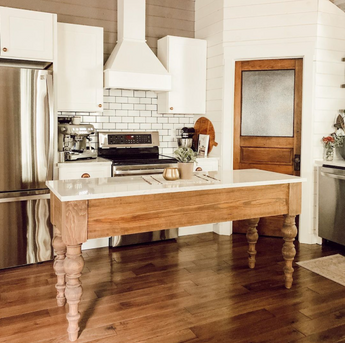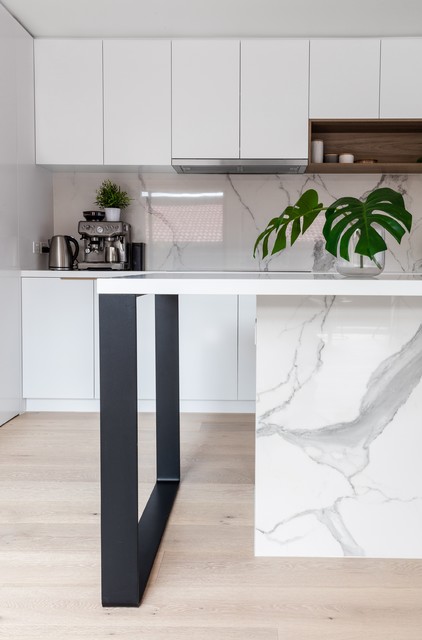Trendy Kitchen Island Legs: Boost Your Kitchen Layout
Trendy Kitchen Island Legs: Boost Your Kitchen Layout
Blog Article
Important Tips for Selecting the Perfect Table for Your Kitchen
Choosing the best table for your kitchen area is greater than simply a matter of taste; it requires a detailed understanding of your space and requirements. Begin by determining your available room to make certain sufficient clearance for motion. The shape of the table plays an essential role; while rectangular tables match bigger areas, rounded ones foster intimacy, and extendable alternatives offer versatility. Product selection is similarly vital, with woods offering sturdiness and glass borrowing a modern-day touch. Lastly, the table should harmonize with your kitchen area's visual appeals and suit your household conveniently. What various other variables might affect this crucial choice?
Action Your Space
Selecting the perfect eating table begins with a careful evaluation of your available area. This foundational action makes certain that the table not only fits comfortably within the space however also matches the overall design and functionality of your eating location. Begin by measuring the measurements of the area, taking right into account entrances, home windows, and any kind of existing furniture. This will aid you identify the maximum allowable size for your table.
Consider the flow of motion around the table. It is necessary to leave appropriate space for chairs to be drawn out and for individuals to relocate around the table without blockage. A basic general rule is to allow a minimum of 36 inches of clearance from the side of the table to the closest wall or item of furnishings. This ensures ease of gain access to and comfort throughout meals.
Additionally, think regarding the variety of individuals you generally delight and whether you require added room for guests. Deciding for an extendable table can provide adaptability, enabling you to fit varying varieties of diners. By properly determining your space, you lay the groundwork for selecting a table that boosts both the aesthetic appeals and functionality of your dining location.
Pick the Right Shape

On the various other hand, round tables are superb for smaller cooking areas or intimate events, as they advertise conversation by enabling everybody to deal with each various other. They also offer a sense of comfort and can fit well in tighter rooms because of their lack of sharp corners. Oval tables provide the finest of both globes, integrating the size of rectangle-shaped tables with the intimacy of round ones, making them functional for different setups.
Square tables are an additional alternative, particularly suited for square-shaped areas. They develop a modern-day and symmetrical look, cultivating an equal dining experience for all seated.
Material Factors To Consider
When picking a dining table, material considerations are extremely important in establishing the table's toughness, upkeep requirements, and total visual. Timber is a traditional selection, providing classic allure and robustness.
Glass-topped tables supply a modern, smooth look and can make a space appear bigger because of their transparency. Nevertheless, they require constant cleaning to protect against finger prints and smudges. Furthermore, tempered glass is suggested for its extra strength and safety.

Finally, composite materials like MDF (Medium-Density Fiberboard) or plywood are affordable alternatives. These materials can simulate the appearance of solid wood however may not offer the same durability. They are generally simpler to tidy yet can be prone to water damage if not appropriately secured.
Eventually, the choice of material must align with your cooking area's design, your lifestyle requires, and your budget plan restraints. (kitchen island legs)
Seating Ability and Convenience
Exactly how do you establish the appropriate seating capability and convenience for your eating table? For a family of four, a rectangle-shaped table of 48 inches long or a round table with a 48-inch diameter is usually enough.
The elevation of the table should ideally be around 30 inches, giving a well balanced ergonomic position for seated diners. Chairs must have a seat height of 18 to 20 inches my review here to guarantee a comfy dining posture.
Design and Appearance
Picking a table that matches your design and looks entails balancing individual preference with the existing design of your eating room. The dining table is often the centerpiece of the cooking area, and its layout ought to complement the general motif of the space. Whether your kitchen area boasts a contemporary, minimal appearance or a rustic, farmhouse charm, the table you choose need to integrate with these elements to develop a cohesive and welcoming ambience.
Consider products thoroughly; wood uses an ageless charm and can range from rich mahogany for a conventional aim to lighter oak for a modern feeling. Steel and glass tables, on the other hand, can present a streamlined, industrial side to your kitchen. Don't ignore the table's shape-- rectangular tables are traditional and versatile, while round and oval alternatives can promote a much more intimate dining experience.
Furthermore, pay attention to surfaces and information. A troubled coating may add personality and heat, whereas a shiny surface can add to a clean, contemporary aesthetic. Inevitably, your table ought to not only in shape flawlessly right into your kitchen's layout but also mirror your individual design, boosting the room both functionally and visually.
Final Thought
In final thought, picking the suitable eating table for a cooking area requires cautious examination of space, shape, material, this contact form seating capability, and aesthetic harmony. Eventually, an appropriate eating table cultivates a welcoming environment and accommodates the home easily, hence boosting the dining experience.

When picking an eating table, material considerations are paramount in establishing the table's toughness, upkeep needs, and total visual. For a household of 4, a rectangular table of 48 inches long or a round table with a 48-inch diameter is normally enough.
Don't forget the table's shape-- rectangular tables are classic and flexible, while round and oval choices can cultivate an extra intimate dining experience. kitchen island legs.
Report this page